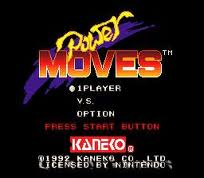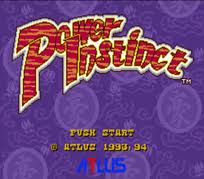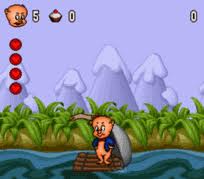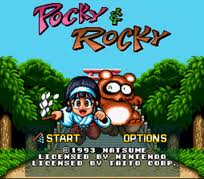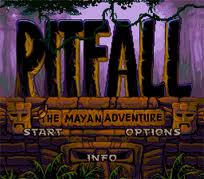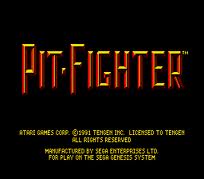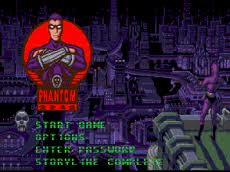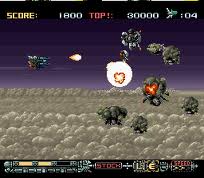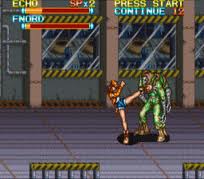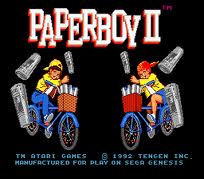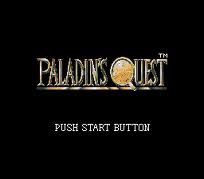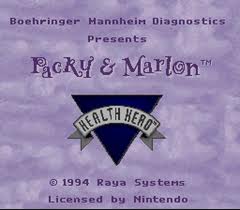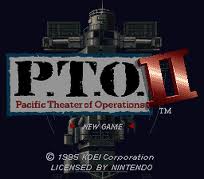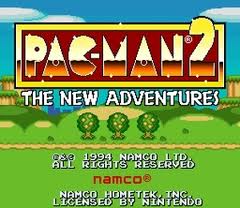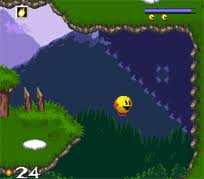Category: Action
732 game(s)All Action games for SNES
Power Moves
Power Athlete (パワーアスリート?), known outside of Japan for the Sega Mega Drive/Genesis as Deadly Moves or for the Super NES as Power Moves, is a 1992 fighting video game developed by System Vision and published by Kaneko. It was first released for the Sega Mega Drive/Genesis in North America on August 14, 1992, and in Japan on November 20, 1992. The Super NES version was later released in Japan on November 27, 1992, North America in January 1993, and in Europe on October 4, 1993. It is one of the many fighting games published in the early 90's to capitalize on the success of Capcom's Street Fighter II, it did not achieve the success of its competition, and was largely ignored by most gamers.
Power Instinct
Power Instinct (豪血寺一族, Gōketsuji Ichizoku?, "The Gōketsuji Clan") is a fighting game series created by Atlus started in 1993. The Power Instinct or Gouketsuji Ichizoku series (often abbreviated as PI or GI for short) is renowned for its more humorous take on fighting games, its music and its often-weird characters.[citation needed]
One of the innovations unique to the series was the introduction of the transformation feature. Several of the characters can change their appearance and fighting style by simply executing certain moves (usually a throwing move), though this has not been featured in every entry in the series. Other features include the ability to perform a double jump and attacking while dashing.
Porky Pig's Haunted Holiday
Porky Pig's Haunted Holiday is a 1995 side-scrolling platform video game developed by Phoenix Interactive Entertainment and published by Sunsoft for the Super Nintendo Entertainment System video game console. The goal of the game is to guide the main character, Porky Pig from the Warner Bros. cartoons, through his nightmares. The game received mixed to positive reviews by critics; its graphics and animations were received well while its length and easy difficulty were not.
Pocky & Rocky
Pocky & Rocky, known in Japan as KiKi KaiKai: Nazo no Kuro Mantle (奇々怪界~謎の黒マント?, "Mysterious Ghost World: The Riddle of the Black Mantle"), is an arcade-style scrolling shooter video game with an anime graphical style. Licensed by Taito to Natsume, who developed and published the game for release in Japan in 1992 and the rest of the world in 1993, it is the sequel to the 1986 arcade game KiKi KaiKai (unofficially released in North America as Knight Boy).
Pocky & Rocky follows the adventures of a young Shinto shrine maiden named Pocky (known in Japan as Sayo-chan (小夜ちゃん?)) and her new companion, Rocky the Tanuki, or raccoon (known in Japan as Manuke (魔奴化?)) trying to save a group of creatures known as the Nopino Goblins. It was generally well received by critics, and the graphics of the game were especially noted. Pocky & Rocky was followed by Pocky & Rocky 2.
Pitfall: The Mayan Adventure
Pitfall: The Mayan Adventure is a 1994 video game developed and published by Activision. A sequel to Activision's 1982 Pitfall! for the Atari 2600, the player controls Pitfall Harry, Jr., son of the protagonist of the original game, as he attempts to rescue his father from a Mayan jungle setting.
Activision developed the game in partnership with Redline Games. It was first released for the Super Nintendo Entertainment System, Sega Genesis/Mega Drive and Sega CD in 1994, followed by releases for the Sega 32X, Atari Jaguar, and PC the following year. The PC release was the first commercial release for the recently debuted Windows 95 operating system. Publisher Majesco Entertainment ported the game for the Game Boy Advance in 2001; a downloadable version appeared on the Nintendo Wii's Virtual Console in 2009.
An extra feature in all versions is the ability to play the original Pitfall! (the Atari 2600 version) after finding a secret doorway within the game. The Sega CD, 32X and Windows ports contained extra (and expanded) levels and other enhancements over the other versions.
The Windows port was based on the Sega 32X version, and was made using Kinesoft's Exodus game technology, which was later used to make the Windows port of Earthworm Jim: Special Edition.[1] It includes 256-colour art, in-game CD music and effects by SOUNDELUX Media Labs. SoftKey version includes America Online free trial software for Windows 3.1/95, Internet Explorer 3.02, Cyber Patrol demo for Windows 3.1/95.
On April 13, 2009, the Sega Genesis/Mega Drive version of Pitfall: The Mayan Adventure was released on the Virtual Console in North America and later in the PAL regions on May 15, 2009 and in Japan on August 25, 2009. It was later delisted on December 26, 2013 in Japan and at the end of 2013 in North America and the PAL regions.
Pit-Fighter
Pit-Fighter is a 1990 arcade fighting game by Atari Games, notable for its early use of digitized live actors. The Japanese arcade release was published by Konami.
The graphic animation for the player character(s) and opponents were created through a bluescreen process, where the various poses & moves of the characters were acted out by hired actors in front of a video camera. The game's on-screen character animation are replays of the actual footage, not a rotoscoped (redrawn) animation as was common in other games. Pit Fighter was the second fighting game to use digitized sprites, after Home Data's Reikai Dōshi: Chinese Exorcist.
Phantom 2040
Phalanx - The Enforce Fighter A-144
Phalanx is a 1991 space shooter video game developed by ZOOM Inc. and Kemco for the Sharp X68000, Super Nintendo Entertainment System and Game Boy Advance. The game was released for the X68000 in Japan in 1991, for the SNES in Japan on August 7, 1992 and in North America in October 1992, and for the GBA in Japan on October 26, 2001, in Europe on November 23, 2001 and in North America on December 27, 2001.
Phalanx is infamous [according to whom?] for the incongruous box art in its American release: it displays a bearded, elderly man dressed in overalls, wearing a fedora and playing a banjo while a futuristic spaceship flies in the background. The popular media site IGN named it their fifth "Most Awesome Cover" in a top 25 countdown on their website.[1] The box art designers later admitted that they had deliberately chosen this theme in order to attract the customer with something original, considering there were many space shooters in the market that looked alike.[citation needed] The Game Boy Advance release redesigned the cover in favor of a prominent spaceship image.
The Peace Keepers
The Peace Keepers, known in Japan as Rushing Beat Syura (ラッシング・ビート修羅 Rasshingu Bīto Shura?) is a beat 'em up video game released for the Super Nintendo in 1993. It is the third game and final game in the Rushing Beat trilogy, following Rival Turf! and Brawl Brothers, although the three games were localized as unrelated titles in North America.
The game distinguishes itself from the rest of the series by shifting focus from the two main characters of the previous games (Douglas Bild and Rick Norton in Japan). It also adds a variety of new features including new special attacks, branching gameplay paths and multiple endings.
Like the previous games in the series, The Peace Keepers features various changes from the original Japanese version. The story was altered, as were various aspects of the game's presentation and gameplay.
Paperboy 2
Paperboy 2 is a sequel to the video game Paperboy. It was released in 1991-1992 for a large number of home systems. While Paperboy debuted in arcades and was subsequently ported to home systems, this game was only released for consumer systems. It was released for the Amiga, Amstrad CPC, Atari ST, DOS, Game Boy, Game Gear, Sega Mega Drive/Genesis, NES, SNES, and ZX Spectrum.
Paladin's Quest
Packy & Marlon
Packy & Marlon is an educational platform video game developed by WaveQuest and published by Raya Systems for the Super Nintendo Entertainment System. It was designed to improve self-care behavior in children with juvenile diabetes. The game achieved some success with treatment groups. It is a part of educational video game series from Raya that includes Captain Novolin, Rex Ronan: Experimental Surgeon and Bronkie the Bronchiasaurus.
Pacific Theater of Operations 2
P.T.O. II (Pacific Theater of Operations), released as Teitoku no Ketsudan II (提督の決断II?) in Japan, is a Koei strategy video game that depicts the conflict between the USA and Japan during World War II. The video game is a sequel to P.T.O.. It was originally released in 1993 for the NEC PC-9801 and had been ported to various platforms since, such as the Super Nintendo Entertainment System.
The NEC PC-9801 version came with an enhancement pack. A version was released exclusive in Japan for the MS-DOS operating system; it also works on Windows operating systems from 3.1 through Windows ME.
Pac-Man 2: The New Adventures
Pac-Man 2: The New Adventures, known in Japan as Hello! Pac-Man (ハロー! パックマン?), is a side-scrolling adventure game "sequel" to Pac-Man. Instead of being a maze game like the majority of its predecessors, Pac-Man 2 incorporates light point-and-click adventure game elements. It was produced and published by Namco for the Super Nintendo Entertainment System (SNES) and Sega Mega Drive/Genesis systems, and was released on April 6, 1994 by Namco. The game borrows its structure and certain elements from Pac-Land, and also appears to contain certain elements from the animated series, such as Pac-Man's family and a main villain commanding the ghosts. The Genesis version was not released in Japan or Europe.
Pac-In-Time
Pac-In-Time (パックインタイム?) is a video game developed by Kalisto and published by Namco, featuring the popular arcade character Pac-Man. It was released in 1994 for MS-DOS, Macintosh, Super Nintendo and Game Boy. It was released shortly after Pac-Man 2: The New Adventures, which brought about the change from the classic arcade versions of Pac-Man to the development of more complex and adventurous games.
This game was an offshoot from the normal variety of Pac-Man games, in that it does not confine Pac-Man to a maze-like board. Rather, the player controls Pac-Man through various side-scrolling levels, obtaining many different items along the way; the plot does take elements from the earlier Pac-Man games, such as the objective to collect a certain number of pellets before exitting a level. The game allows the player to access completed levels via passwords that are given every five levels.
